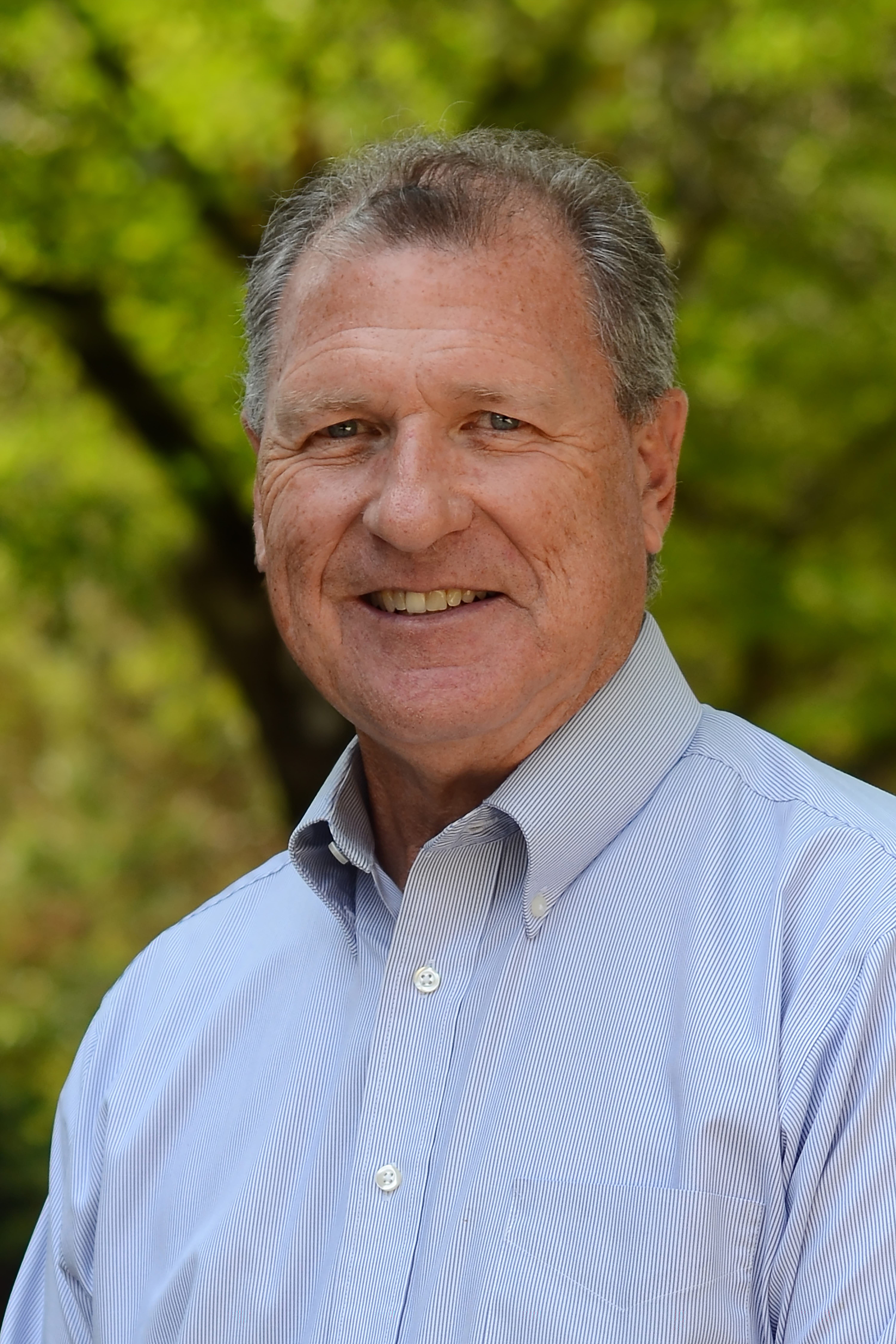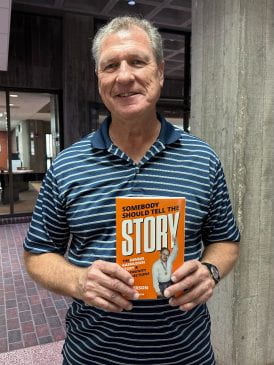From Basketball Star to Biographer, Tom Anderson (’78) is Telling a New Story

In 2010, Tom Anderson lost a friend, Dennis Rasmussen. A beloved figure in Green Bay area sports, Rasmussen had an intellectual disability, but it didn’t define him. It was his spirit, his compassion and his love of athletics that left an enduring mark on his community. When he passed, Anderson felt compelled to tell his old friend’s story.
“I had a calling,” said Anderson, a former All-American athlete who played for UW-Green Bay Phoenix men’s basketball from 1974 to 1978. His book, Somebody Should Tell the Story, was published earlier this month.
A Calling

Anderson never imagined himself an author. He has held many roles in his life—basketballer, accountant, company president, husband and father—but “biographer” came unexpectedly.
Anderson’s calling happened at Rasmussen’s visitation, where he realized just how much of an impact his friend had made on those around him.
Rasmussen had made friends everywhere from Little League teams, where he served as bat boy, to Aspiro, where he was a longtime client and employee, to the Green Bay Packers, where he worked in the mailroom. Anderson saw those connections laid out in the form of hundreds of photos at the visitation.
All those people—in the photos, in the room and in the stories people told—were connected. A nexus of relationships, like strands of spider silk, originated with Dennis and looped around every life he touched, even the most distant points still joined by the same web. “Somebody should tell the story,” Anderson thought, and who better to write it than him?
Growing Up With Dennis
Anderson’s own connection to Rasmussen started in childhood. The two met through Little League. He grew up playing sports and Rasmussen was a constant presence in his community. One particular memory from high school, which Anderson included in his book, comes to mind when he thinks of those days.
It was a Babe Ruth League game and Anderson was playing on a recently-healed broken leg. He made a choice to slide home—against doctor’s orders—and the umpire called him out anyway (unjustly, as Anderson remembers it). In response, he had an uncharacteristic outburst. “I said ‘for God’s sake,’” Anderson recalled, “and I got kicked out of the game.”
After his expulsion, Anderson remembers Rasmussen putting his arm around him and comforting him, telling him that one game didn’t matter much and that he would learn from his mistake. “He showed me a tremendous amount of compassion,” Anderson said.
That compassion was hardly a rare experience with Rasmussen. The more people Anderson talked to, the more he realized that. He began interviewing mutual friends and acquaintances, but his list of contacts kept growing as each interviewee recommended more and more people to talk to.
Over the years, that list grew to almost 70 people, all with something to say about Dennis Rasmussen. “I had to cut it off at some point because I could still be going and I wouldn’t ever get the book written,” said Anderson.
All those interviews helped fill in the gaps of Rasmussen’s story that Anderson didn’t experience directly. While Rasmussen and Anderson influenced each other greatly, when the latter went to UW-Green Bay, the two grew apart
Phoenix Basketball
Tom Anderson’s life got very busy at UW-Green Bay. In his years with the then-Division II program, his team grew from a scrappy, inexperienced bunch of players to a powerhouse team that reached the NCAA Division II National Championship game in 1978, Anderson’s senior year.
Anderson was a standout player. He still holds the Phoenix men’s basketball record for most assists in a season, is among the top 10 career scorers in program history and is second only to Tony Bennett in career assists.
After graduation, he was drafted to the Milwaukee Bucks, though he never played. “That didn’t last very long,” said Anderson. “The physical abilities of the players, it’s just tremendous, and I wasn’t quite up at that level.” He considered playing abroad in Europe, but he instead opted to stay in Green Bay to focus on his family and his career.
A Reunion
Anderson and Rasmussen’s paths diverged for a while, but they reunited in 2009 at a 40-year reunion of the Southwest Kiwanis Little League All-Star team. 12 of the 14 members of the 1969 team that came two games short of a national championship reunited in Green Bay’s Colburn Park where they played games decades ago. It was only fitting that their batboy and constant cheerleader Dennis came too.
Anderson’s wife, Laurie, shot a photo at the reunion. Afterwards, Tom thought to bring a copy to Dennis. He travelled to Rasmussen’s group home, and stopped by his room. Rasmussen was there, but he was uncharacteristically quiet, not the energetic and talkative man from most of Anderson’s memories. Rasmussen took the photo, thanked Anderson, and left. There was an invisible barrier between them, the product of an untended relationship.
That moment still sticks with Anderson. He wishes he had kept better contact over the years.
Rasmussen died shortly after the reunion. Writing Rasmussen’s biography was, in a way, a method for Anderson to work through the complicated feelings of losing connection. He found that experience was more common than not–everyone wishes they had made one more call or paid one more visit. Anderson remembers a friend telling him, “Dennis is giving you another blessing by you doing this book.”
The Hurdles of Authorship

Tom Anderson with the print copy of his new novel
Knowing he wanted to tell Dennis Rasmussen’s story was clear, but the process of writing and publishing a book was much more opaque. “I have an accounting type brain. I’m very factual, right? So, I’m not a storyteller,” said Anderson. But, he found help revising with the help of a local editor, his publisher and friends and family that gave him feedback on bringing storytelling into his factual recounting.
Over the course of writing, Anderson retired from working. Interviewing, writing, publishing and distributing became almost a full-time job, Anderson said, “My wife can speak to that.”
Now that the book is published, Anderson is working with local schools to get it in the hands of young people. His hope is that Dennis Rasmussen’s story can provide both an inspirational story and a historical perspective on disability. At a time when people with intellectual disabilities were sooner shunned than celebrated, Rasmussen’s enthusiasm for sports broke through the artifice of human differences.
Let Others Talk About You
While Anderson has devoted tremendous effort into telling someone else’s story, but he is often reticent to tell his own. He attributes that approach to advice from his father, who told him, “Let others talk about you; don’t talk about yourself.”
Still, Anderson had a moment in the spotlight when his jersey, number 40, was retired this year. He, Dennis Woelffer and Ron Ripley were honored at the Resch Center during a men’s basketball game in January.
Anderson says what made the moment special was having his kids and grandkids there with him. He said when video played of him in the 70s making shots and running up and down the court, some of his loved ones were surprised. “They didn’t have any idea that I ever did that,” said Anderson.
There are always more stories to tell.
Somebody Should Tell the Story: The Dennis Rasmussen Story is available to order now.


